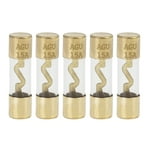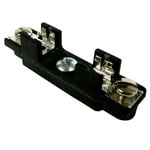We are not walking the same path, My road is parallel than yours; sespect.

My goal is stable 30A 200W-300W in the same little pcb, with one heating semiconductor and one cpu cooler.
Yours goal; looks to me; - stable 60-100V or more, and 5-10A or more, with multiple semiconductors and coolers...
If we are leaving the earth, we are going out into space, we reach the dream world, the world of 1000Ws, then 2kW, and then 3kW power.

There may be obstacles and physical limits along the way. During I leave the 20A current level; the little buddy smd-schottkys life must be saved.
Yes, your friend can do a little better on that little heatsink. If you don't go higher than 20A current, you have nothing to worry about, also not for fuse heating...
I had also little experience in car audio - long time ago I worked as an employee for a few years in a car-audio and car-electric garage;
We used somthing like this type fansy, gold-plated, expensive fuse. - which once got really hot


I know there is a better fuse holder for this type of fuse, but the Hungarian customers wanted high volume, power and not the expensive equipment.
Then we started to use this type fuses (- for pennies):


- the M5 or M6 screws was strong enough no more contact heating.
On the electronic load, I say goodbye to the diode-friend in the short term, and I will solder one SMD fuse 35 or 40A (125VDC / 1000A breaking capacity, and less than 2mΩ resistance) to the same place.
On the sidelines of the discussion IGBT vs MOSFET:
there was a similar topic before:
https://www.eevblog.com/forum/projects/igbt-vs-mosfet-for-dummy-load/I asked the creator of the topic (OM2220) in private message; he finally using a darlington transistor, not an IGBT
He advised me to choose the cheapest one (FET, Darlington or IGBT), with enough safe dc operating area, You do not need linear MOSFET - wrote.
Yes, If high enough the Beta of the tranzistor, the FET-driver can drive with no problem; You can use many semiconductors if you cool them down well.
- there is no speed or linearity here, there is only heat, lots of heat.